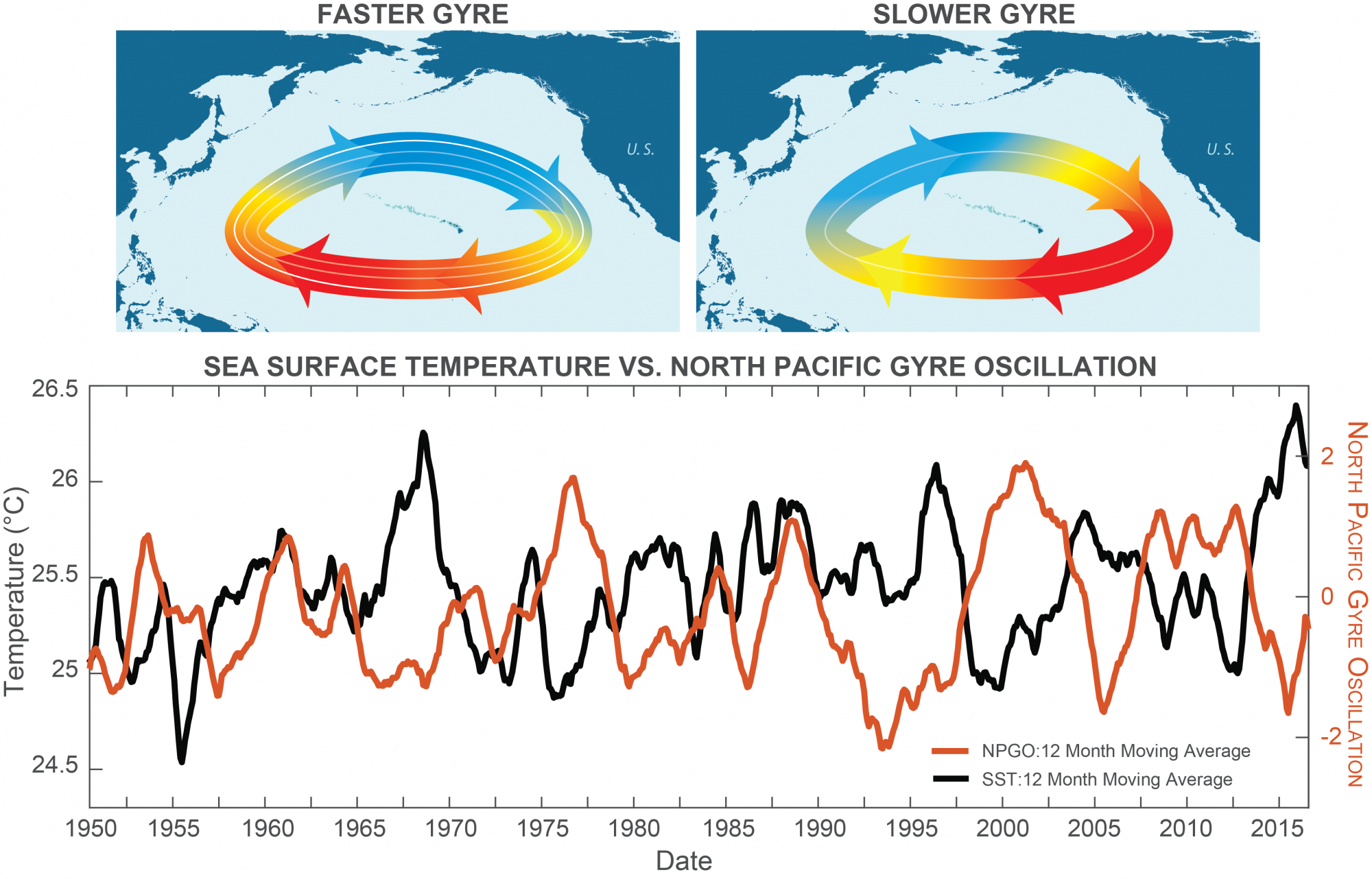Why was 2015 so hot?
Sea surface temperature (SST) in the main Hawaiian Islands reached the highest recorded monthly temperature in well over a century (Figure 1). Temperatures in West Hawai‘i were even warmer, reaching 30.3°C (86.5°F) in September of 2015 (Gove et al. 2016). These anomalously warm and prolonged ocean conditions wreaked havoc on coral reefs in West Hawai‘i, causing upwards of 90% of coral bleaching and an overall relative loss of approximately 50% of coral cover across West Hawai‘i (Kramer et al. 2016).

Although the dynamics governing ocean temperatures can be complex, it appears that the combination of local conditions and large-scale climate processes superimposed to produce the extremely warm temperatures observed in Hawai‘i in the summer of 2015. Here, we provide a descriptive and generalized explanation of this anomaly.
One source of variation in ocean temperatures is driven by the speed of the Subtropical Gyre, a ring-link system of ocean currents rotating clockwise across the North Pacific (Figure 2). Ocean currents in the Subtropical Gyre transport cooler waters from the northeast Pacific to the west and south, warming as it moves to the subtropical Pacific and the vicinity of Hawai‘i. Similarly, warm water from the western subtropical Pacific is transported towards Japan, cooling as it moves northward. When the rotational speed of ocean currents in the Subtropical Gyre is accelerated, cool waters from the northeast take less time to reach Hawai‘i, arriving cooler than normal, while the warm water in the western Pacific arrives warmer when it reaches Japan (Figure 3.4, Fast Gyre). Conversely, when the rotational speed of ocean currents in the Subtropical Gyre are slowed, cool waters from the northeast take more time to reach Hawai‘i and, therefore, arrive warmer than normal (Figure 2, Slow Gyre).

The North Pacific Gyre Oscillation (NPGO) is an indicator of the variation in the rotational speed of ocean currents in the Subtropical Gyre (Di Lorenzo et al. 2008). When comparing the NPGO and sea surface temperature in Hawai‘i, there is clearly a negative correlation—warmer SST is coincident with a lower NPGO, or slower Subtropical Gyre, and vice versa (Figure 1, Sea Surface Temperature vs. North Pacific Gyre Oscillation). The NPGO captures much of the decadal variation in SST around Hawai‘i, including the warm temperatures observed in 2015. However, while September 2015 represented a decadal peak in SST, the NPGO alone was not sufficient to result in such anomalously warm ocean temperatures.
In addition to the rotational speed of the Subtropical Gyre, two other broad-scale climate processes can drive variation in ocean temperatures around Hawai‘i. The first is the El Niño Southern Oscillation (ENSO). ENSO is an irregular (3–7 years), ocean-atmosphere climate phenomenon. El Niño represents the warm phase of the ENSO cycle, characterized by weakening of the trade winds across much of the Pacific and warming of ocean temperatures in the Equatorial Pacific (Figure 3). El Niño events typically last 9–15 months, with peak forcing occurring in the northern hemisphere winter. La Niña represents the cool phase and is associated with stronger than normal trade winds and the anomalously cool ocean temperatures (Philander 1990). On average, La Niña is a less extreme anomaly than El Niño but tends to last longer, approximately 1–3 years.
The second major climatic driver of changes in ocean temperatures in Hawai‘i is the Pacific Decadal Oscillation (PDO). The PDO is often described as a long-lived ENSO-like pattern of Pacific climate variability. As seen with the better-known ENSO, extremes in the PDO pattern are marked by widespread variations in temperature, wind patterns, ocean mixing, and biological productivity (Polovina et al. 1994). The extreme phases of the PDO have been classified as either warm or cool, defined by ocean temperature anomalies in the northeast and tropical Pacific Ocean (Figure 3).

In 2015, there was both a powerful El Niño and a warm phase of the PDO (Figure 4, ENSO & PDO Time Series), resulting in higher local ocean temperatures than either alone would typically produce. In 2014 and 2015, the equatorial and mid-latitude connection between the El Niño and warm phase of the PDO is thought to have been especially strong, resulting in the largest marine heat wave (i.e., “The Blob”) ever recorded in the Northeast Pacific that caused enhanced ocean warming across the Hawaiian Islands (Di Lorenzo & Mantua 2016).

On a local scale, variations in wind conditions likely exacerbated the warming induced by the large-scale climate processes previously described. When winds are weaker than normal, they decrease the intensity of ocean mixing, which reduces the amount of deeper, cooler waters reaching the surface ocean, and results in increased warming. Throughout August and early September of 2015, wind speeds were weaker than average over 80% of the time (Figure 5). During this same period, reef-level (10 m; 33 ft) temperatures from Lapakahi, located 16 km (~10 miles) north of Kawaihae, increased by over 2.5°C (4.6°F) (Figure 5). At the peak of the warming event, local wind speeds were equal to or stronger than the long-term average for more than two weeks, helping to mix the upper surface and drive down ocean temperatures, ultimately contributing to the end of the 2015 thermal stress event.

Thus, the typical seasonal cycle, reduced wind conditions, and the combination of three major large-scale climate phenomena—NPGO, ENSO, PDO—all contributed to producing the highly anomalous warm ocean temperature around Hawai‘i in September 2015. Looking toward the future, ocean temperature in West Hawai‘i is projected to steadily increase as a result of climate change (Figure 6). By the middle of the century, average monthly SST will be about 1°C (1.8°F) warmer than present-day, and for about 6 months of the year will be warmer than the present-day average September SST (27°C; 80.6°F) (van Hooidonk et al. 2016). Further, it is likely the climate models used in these projections do not fully capture the large-scale climate variability—NGPO, ENSO, PDO—that influence SST and, therefore, may underestimate future ocean temperatures in West Hawai‘i.

